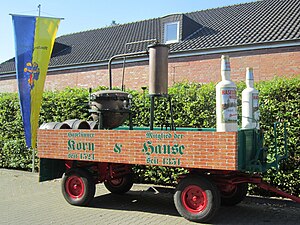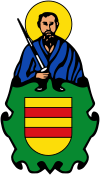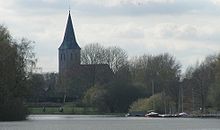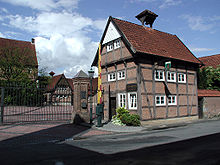Haselünne
| coat of arms | Germany map | |
|---|---|---|
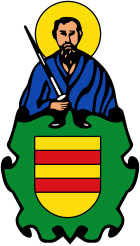
|
Coordinates: 52 ° 40 ′ N , 7 ° 29 ′ E |
|
| Basic data | ||
| State : | Lower Saxony | |
| County : | Emsland | |
| Height : | 20 m above sea level NHN | |
| Area : | 159.31 km 2 | |
| Residents: | 13,029 (Dec. 31, 2019) | |
| Population density : | 82 inhabitants per km 2 | |
| Postal code : | 49740 | |
| Primaries : | 05961, 05962, 05963, 05965 | |
| License plate : | Tbsp | |
| Community key : | 03 4 54 019 | |
| LOCODE : | DE HNN | |
City administration address : |
Rathausplatz 1 49740 Haselünne |
|
| Website : | ||
| Mayor : | Werner Schräer ( CDU ) | |
| Location of the town of Haselünne in the Emsland district | ||
Haselünne is a town in the Emsland in the Hasetal in Lower Saxony .
geography
Geographical location
Haselünne is located on the Hase River in the central part of the Emsland . It is located around 13 kilometers east of Meppen ( district town of the Emsland district) and around 20 kilometers northeast of Lingen (Ems) .
Neighboring communities
Haselünne borders in the north on the Sögel municipality , in the east on the Herzlake municipality , in the south on the Lengerich municipality and the municipality Geeste and in the west on the city of Meppen .
City structure
In addition to the core town of Haselünne, the city includes the districts of Andrup , Bückelte , Dörgen , Eltern , Flechum , Hamm , Huden , Hülsen , Klosterholte , Lage , Lahre , Lehrte , Lohe , Lotten and Westerloh .
climate
Temperate maritime climate influenced by humid northwest winds from the North Sea . On a long-term average, the air temperature in Haselünne reaches 8.5–9.0 ° C and around 700 mm of precipitation falls . Between May and August, an average of 20-25 summer days (climatological term for days on which the maximum temperature exceeds 25 ° C) can be expected.
history
Archaeological finds and barrows point to a settlement in what is now the city of Haselünne in the Younger Stone Age. The Haselünne-Dörgen residential area was discovered in 1935 by F. Wolf in the area of a sand extraction point . Around 500 AD there was a main Saxon courtyard in the area of today's court. In the nearby course of the river, a ford was built using round timber. These round timbers were called "lunni" and they gave the place the name "Lunni", "Lunne" and with the river name "Hassa" = dark water = rabbit finally the name Haselünne.
In 834, Emperor Ludwig the Pious , successor and son of Charlemagne , gave Corvey Meppen monastery with all its accessories. This also included the church with the main courtyard Lunni. Around the year 1000 the Lunni manor was mentioned several times in the Corvey tax registers. At the same time Haselünne is officially named "oppidum", which translates as "Wigbold" = fortified trading center. With the designation "oppidum" the supra-regional importance of the place should be emphasized. Around 1130 the Lunni court was inherited by the Counts of Vechta-Ravensburg.
In 1252 the Bishop of Münster bought the Ravensburger possessions. The town charter, which Haselünne received before 1250, was "mentioned and renewed" in a document on March 25, 1272 by the Bishop of Münster. The city belonged to the alliance of cities between the Rhine and Elbe, which was founded in 1268 to protect and defend each other against disruptors of trade. This federation later expanded into the Hanseatic League (documented mention in 1351). Haselünne belonged to the Niederstift of the Principality of Münster for 550 years .
On February 25, 1803, the ecclesiastical principalities were dissolved by the Reichsdeputationshauptschluss . Haselünne came under the rule of the Duke of Arenberg . In 1826 state sovereignty passed to the Kingdom of Hanover . After the war between Prussia and Austria in 1866 (" German War "), the Kingdom of Hanover (and with it Haselünne) fell to Prussia. The city has belonged to the state of Lower Saxony since 1946 .
In 1977 Haselünne also went to the district of Emsland, which was founded at that time from the old districts of Aschendorf-Hümmling, Meppen and Lingen (Ems) .
Historical data
- 1025: Haselünne receives market rights
- 1252: The Bishop of Munster buys the Ravensberg estates, Haselünne now belonged to the Lower Monastery of Munster .
- 1272: The Bishop of Münster renews the town charter that Haselünne had already received.
- 1636: Battle of Haselünne in the Thirty Years War
- 1733: On July 11th, 45 buildings are destroyed by fire
- 1751: Another city fire in which 51 houses are cremated
- 1798: On October 18, a fire breaks out in the house of the procurator Anton Pattkamp on Hasestraße, which spreads to Achterstraße, Steintorstraße and the market. About 80 houses are destroyed by flames. Town hall and pharmacy can be saved.
- 1803: The Münster Hochstift is dissolved due to the resolutions of the Reichsdeputationshauptschluss . The Meppen office and thus Haselünne went to the Duke of Arenberg as a replacement for the loss of his areas on the left bank of the Rhine.
- 1810: Haselünne becomes part of the French Empire .
- 1815: State sovereignty passes to the Kingdom of Hanover .
- 1849: 101 houses are destroyed in the great fire of August 10th
- 1866: The Kingdom of Hanover , and with it Haselünne, becomes Prussian .
- 1894: The Meppen-Haselünner Railway opens the eponymous railway line from Meppen to Haselünne
- April 9, 1945: Western Allied troops occupy Haselünne.
- 1946: The city belongs to the newly formed state of Lower Saxony.
- 1977: During the district reform of Lower Saxony , the former districts of Lingen , Meppen and Aschendorf-Hümmling are merged into the district of Emsland on August 1st .
Incorporations
On March 1, 1974, the following places were incorporated:
- Andrup (397)
- Hunched over
- Dörgen (139)
- Parents (764)
- Flechum (522)
- Hamm (80)
- Huden (130)
- Sleeves (148)
- Klosterholte
- Location (183)
- Years
- Taught (573)
- Tan (272)
- Lotten
- Westerloh (332)
Origin and meaning of the names
- Bückelte : The name of the place was called Boclithi in ancient times , which means beech- lined slope; "Lithi" can be found both as a defining word and as a basic word and means dependent terrain.
- Dörgen : “ing”, “ingen” means coming from, derived from…, but it also seems to be used for groups of houses. Around 1000 daringons or deringons . However, it cannot be ruled out that this is based on an old personal name.
religion
The population is predominantly Roman Catholic (78.9%), 11.7% are Evangelical Lutheran, 1.01% Muslim, 0.37% Evangelical Reformed, 0.22% Jewish, 0.13% belong to the Witnesses Jehovah and 7.67% do not belong to any or any other religion. As of March 1, 2006
politics
Haselünne has the status of a unified municipality .
City council
The city council of Haselünne consists of 30 councilors. This is the specified number for a city with a population between 12,001 and 15,000. The 30 councilors are elected by local elections for five years each.
The full-time mayor Werner Schräer (CDU) is also entitled to vote in the city council.
After the municipal elections on September 11, 2011, the city council consisted of two parties and one individual member:
The municipal elections of September 11, 2016 resulted in a turnout of 59.8% to the following conclusion:
| list | Share of votes | +/- | Seats |
| CDU | 67.10% | - 3.95% p | 20th |
| SPD | 31.28% | + 2.33% p | 9 |
| NPD | 1.62% | + 1.62% p | 1 |
The electoral term begins on November 1, 2016 and ends on October 31, 2021.
coat of arms
|
Blazon : The coat of arms of the city of Haselünne shows a shield with two red horizontal bars on a golden background, which is placed on a shield plate with ornate edges, which is held by the figure of Saint Paul , whose right hand includes a sword pointing upwards . The heraldically correct blazon reads: “The coat of arms of the town Haselünne shows behind a green high renaissance shield; on it a small golden (yellow) shield, covered with two red bars, the St. Paul in blue robe and golden (yellow) halo , in his right hand a silver (white) sword. " Emperor Friedrich II granted Haselünne the privileges of a town around 1230/1240 under Count Hermann and Otto von Ravensberg. Count Otto von Ravensberg died in 1238. His wife Jutta, born in Oldenburg, inherited the town of Haselünne, among other things. Jutta felt more like an Oldenburg woman and introduced the five-part Oldenburg bar coat of arms . In 1252 Jutta von Ravensberg sold the town of Haselünne to the Prince-Bishop of Münster. This confirmed the city charter in 1272 and ordered St. Paul to be included in the city arms. Obviously, the Haselünner ignored this for a long time, because there is evidence that St. Paul only appeared in the city's coat of arms in 1760. |
flag
|
The colors of the town of Haselünne are “blue and white”. The banner is blue-white-blue in a ratio of 1: 2: 1 striped lengthways with the coat of arms above the center. |
Town twinning
| city | country | since |
|---|---|---|
| Elburg |
|
1989 |
| Saint-Flour (Cantal) |
|
1992 |
Culture and sights
Museums
- Local museum
- Distillery Museum
Buildings
The St. Vincentius Church is a three-aisled late Gothic hall church and was probably built in the last third of the 15th century. The oldest piece of equipment is the Romanesque baptismal font of the Bentheim type, which belongs to the 13th century and is carried by four lions. Further furnishings include the epitaphs of the old Burgmann families, chandeliers, baroque paintings, a valuable Pieta, a 5 m triumphal cross and an organ from the Werler organ building workshop Stockmann .
Only the monastery church , consecrated in 1685, remained of the Poor Clare Monastery built in the Neustadt from 1668 . It is a hall church with a polygonal choir, which was originally crowned by a ridge turret. In 1906 this was replaced by the existing tower. Only a few pieces of the baroque interior have been preserved, which are now in St. Vincentius. Between 1960 and 1966 the church contained new glazing, which was created by the artist Vinzenz Pieper from Angelmodde . At the site of the monastery building , the extensive complex St. Ursula District High School extends today. Parts of the monastery wall can still be seen on the Nonnenwall , which was probably built on the foundations of the first city fortifications.
The old town hall on the market square was built in 1850 by the architect Josef Niehaus in a round arch style. The brick building, which was later changed, was restored in its original form in 1989.
A total of 22 Burgmannshöfe can be found in the city , of which only a small part exists. Today you are mainly concentrating on the Ritterstrasse area .
The three-storey stone work of the Hof von Langen / von Westerholt (Ritterstraße 7), which is one of the most important medieval secular buildings in the Emsland, is particularly well preserved . The building, made of boulders and bricks, contains a large hall with an altar niche and a late Gothic fireplace from the end of the 15th century on the ground floor. Gertrud von Schatte († after 1440) brought the Schwakenburg near Andrup and the Burgmannshof into her marriage to the Burgmann Engelbert I. von Langen zu Kreyenborg. The court then came through the von Hake through marriage to Michael Wilhelm Kobolt von Tambach († 1667) and later to the Counts of Westerholt . After another change of ownership, the property was transferred to the Berentzen distilleries in 1893 , which recently restored the old Adelshof.
Further to the east, at 9 Ritterstraße, is the Dwingelo farm , whose owners had been part of the castle team since 1446. In 1761 the property came to the von der Hude family . A sundial marked in 1758 is attached to the exterior . The foundations of the Hüntelhof (Ritterstrasse 5) are said to date back to the 14th century. At the site of Hasestraße 19 there was presumably the court of Johann von Schwenke . Between 1652 and 1669 the house was used as accommodation for the nuns until the Poor Clare Monastery was completed. In the 18th century the building came into the possession of the merchant and mayor Anton Niehaus. It was later used as a sexton's apartment . The heavily modified half-timbered building, the gable of which protrudes over volute studs, rises above an older stone cellar. The half-timbering in the gable triangle is likely to date from the late 17th or 18th century, the left extension from around 1800. There are also two residential buildings on Steintorstraße , which were also built on the foundations of two courtyards destroyed in the town fire of 1798. Both are said to have been built according to plans by August Reinking , a building inspector from the Arenberg region . The house of the wine merchant Russel, Steintorstraße 7 , is a single-storey brick building with a high mansard roof and a central projection. The well-preserved interior with its oval ballroom is used for gastronomy today. The diagonally opposite Haus Wiedehage (Steintorstraße 9) is designed in a similar way and still has a historical staircase.
After several city fires (1733, 1751, 1798, 1849) and extensive renovation measures, only a few older residential buildings remain in the city center. Formerly likely storey timber-framed hall houses with over cleats have been prevalent projecting gables, as they are still in similar form today Quakenbrück are repeatedly encountered. The house Nonnenwall 3 , which is one of the few that still has a hall gate, gives a very good impression of this construction method . According to the inscription on the gate, it was created immediately after a town fire: 1733 DURCH BRENNEN BALLIG NOW IS DESERTED BY HIS OHM REBUILDED IS DESIRED THE 2ND MARTYS ONE SHOULD ASK FOR THE OTHER - - JOHAN MOORMAN AESTIMATOR AND COURT FOR GERARD VETESSE - - PAX INTRANTIBUS IHS SALUS EXEUNTIBUS - SOLI DEO GLORIA. Also worth mentioning are the inn "Zum alten Bock", Petersilienstraße 23 from 1698 and No. 27 from 1751 (heavily renovated). In later times the half-timbered buildings were often provided with brick fronts, so that these appear as solid buildings today. However, a look into the eaves often reveals the older half-timbered core. The city fire of 1849, which hit large parts of the city center, changed the image of Haselünne decisively. In the course of the subsequent reconstruction, which was carried out by the city architect Josef Niehaus, a. a. the Marktstrasse was considerably redesigned. The layout of the plots was changed here as well as the street width. Niehaus broke with the tradition at the gable end and built a number of brick buildings with eaves in the nearby Hasestrasse . This includes the Vehmeyer house , Hasestrasse 25, which he created in 1851 for a relative. Today, the inner city is characterized in many places by clinker-clad, multi-storey new buildings that are increasingly displacing the single-storey residential buildings. The historical building group at Petersilienstraße 17-21 across from St. Vincentius are all solid structures with pseudo-timber framing. They only emerged since the late 1970s.
More Attractions
Various fountains in the city have been transformed into so-called Easter fountains by Haselünner elementary school students since 2006.
- Iron sculpture "Cyclist" by Joe Siewe (station on the Hasetal Art Route )
- Buckelter Chapel
Nature reserves
- On Troendoj
- Dörgener Moor
- Langenberger Moor
- Natura 2000 nature reserve in the lower Haseniederung (in the 2017 designated nature reserve the previous nature reserves Hase Island and Hase Altarm , Hasealtarm near Wester , Haselünner Kuhweide as the largest contiguous juniper grove in northwest Germany, Koppelwiesen , Lahrer Moor and Negengehren )
- Pigfehn
- Stadtveen
Sports
The Haselünner SV from 1920 eV . , also called the "smaller" HSV, was founded in 1920 and offers football , handball , swimming , volleyball , gymnastics , cycling , table tennis , gymnastics , athletics and bowling . The first football team of Haselünner SV has been playing in the 1st district class middle since the 2016/2017 season, the home games take place in the Hasestadion .
Regular events
- Haselünner See in Flames (every two years)
- Corn and Hanseatic market (every two years on the second weekend in September)
- Fair in October (annually)
- Old Town Run (annually)
- Haselünne blossoms (spring market for trade and crafts, every two years)
- Decorated Easter fountain (every two weeks around Easter)
- Easter fire (annually)
Economy and Infrastructure
economy
The most important employers in Haselünne can be found in the beverage industry. In the spirits sector, the Berentzen , Heydt and Rosche companies should be mentioned , and VivarisGetränke (formerly Emsland Getränke) in the soft drinks sector . Another important employer is the company Conditess, an industrial manufacturer of various ready-made baked goods. Tourism has been gaining in importance for years.
traffic
Haselünne lies at the intersection of the federal highways B 213 and B 402 . The federal motorway A 31 is located behind Meppen (20 km) in the direction of Emden and behind Lingen (Ems) (30 km) in the direction of Oberhausen.
Haselünne is connected to the rail network through the Meppen – Essen / Oldbg line. connected to the Emsland Railway , which only carries goods and museum traffic . There is a bus connection to Meppen train station (Kalmer, every 30 minutes). After an accident on July 31, 2014, in which a freight train severely damaged the track system, the museum railway operation was temporarily suspended, but was resumed in 2015 after the track had been repaired.
The Hase-Ems-Tour long-distance cycle route runs along the Hase. The route in its section between Bersenbrück and Meppen is identical to that of the Hasetal Art Route. The hare can be used as a traffic route by water sports enthusiasts , especially canoeists .
Personalities
sons and daughters of the town
The following people were born in Haselünne:
- Johann-Franz Riccius (1666–1756), Auxiliary Bishop of Strasbourg
- Karl Immendorf (1692–1752), Jesuit
- Josef Niehaus (1802–1864), late classicist architect
- Anton Franz Johann Russell (1824–1878), member of the Reichstag and Landtag
- Anton Dreesmann (1854–1934), founder of the Dutch department store chain Vroom & Dreesmann
- Heinrich Többen (1880–1951), forensic doctor, forensic psychiatrist and university professor
- Hans Berentzen (1927–2005), entrepreneur ( Berentzen Group AG )
- Friedrich Berentzen (1928–2009), entrepreneur (Berentzen Group AG)
- Matthias Gatzemeier (* 1937), philosopher
- Bernhard Robben (* 1955), translator
- Tobias Sudhoff (* 1972), cabaret artist, jazz musician and author
- Said Bahaji (* 1975), alleged Islamist terrorist and alleged member of the Hamburg terrorist cell that was involved in the terrorist attacks on September 11, 2001 in the USA.
- Jens Robben (* 1983), soccer player
- Tobias Kroner (* 1985), speedway racing driver
- Leon Demaj (* 1997), football player
Personalities who have worked in this city
The following people are connected to Haselünne in other ways:
- Dodo Freiherr zu Innhausen and Knyphausen (1583-1636), general in the Thirty Years' War , died on January 1, 1636 in the battle of Haselünne .
- Wilhelm Anton Riedemann (1832–1920), honorary citizen of the city of Meppen, inventor of the first tanker, co-founder of Exxon-Mobil.
- Tonio Bödiker (1843–1907), Prussian statesman and first President of the Reich Insurance Office , born in Meppen , spent his childhood in Haselünne.
- Wilhelm Guddorf (1902–1943), journalist and resistance fighter in the Third Reich, spent part of his school days in Haselünne.
literature
- Hans Berentzen: 700 years of the city of Haselünne: 1272–1972. Haselünne 1972.
- IB Berentzen: Burgmannshöfe zu Haselünne. Haselünne 1983.
- Alexander Geppert and Ernst Simmer: Home book of the city Haselünne . Haseluenne 1949.
- Catholic parish of St. Vinzentius: St. Vinzentius zu Haselünne . Haselünne 1977.
- District Emsland (Ed.): Cultural guide of the district Emsland: Architectural monuments. Meppen 1993, pp. 145-157.
- Anna Nieters: The development of population, settlement and economy of the town of Haselünne in the recent post-war period, in: Studiengesellschaft für Emsländische Regionalgeschichte (Ed.), Emsländische Geschichte 25, Haselünne 2018, pp. 223–290.
- Roswitha Poppe: Architectural and art monuments in the Meppen district . Meppen 1974.
Web links
References and comments
- ↑ State Office for Statistics Lower Saxony, LSN-Online regional database, Table 12411: Update of the population, as of December 31, 2019 ( help ).
- ↑ info-haseluenne.de
- ^ Federal Statistical Office (ed.): Historical municipality directory for the Federal Republic of Germany. Name, border and key number changes in municipalities, counties and administrative districts from May 27, 1970 to December 31, 1982 . W. Kohlhammer GmbH, Stuttgart / Mainz 1983, ISBN 3-17-003263-1 , p. 257 .
- ^ Lower Saxony Municipal Constitutional Law (NKomVG) in the version of December 17, 2010; Section 46 - Number of MPs , accessed on September 3, 2013
- ↑ Council of the City of Haselünne, electoral period November 1, 2011 - October 31 , 2016 , accessed on July 30, 2014
- ↑ Result of the 2016 municipal elections on September 11, 2016 City of Haselünne , accessed on November 3, 2017
- ↑ a b Main Statute of the City of Haselünne (PDF; 23 kB), accessed on September 3, 2013
- ↑ For the dating see: Poppe: Bau- und Kunstdenkmäler im Kreise Meppen, p. 14/15 and Dehio: Handbuch der deutschen Kunstdenkmäler Bremen / Lower Saxony, Munich / Berlin 1992, p. 653.
- ↑ Information according to the house directory of the town of Haselünne
- ^ Lower Saxony education server: Osterbrunnen . 2006
- ↑ Haselünner SV von 1920 eV website , accessed on September 3, 2013



